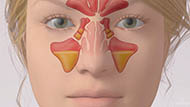Sinus Surgery for Sinusitis
Surgery Overview
In traditional sinus surgery, an opening is made into the sinus. The opening may be made from inside the mouth or through the skin of the face.
- There are a number of possible approaches depending on the location of the infected sinus and what the doctor prefers.
- Working through the incision, the doctor can remove tissue that is blocking the sinus and preventing drainage.
- More extensive procedures may involve leaving a temporary opening to help drain the infection.
Most of these procedures require admission to a hospital.
What To Expect
Recovery from surgery may involve:
- Packing the nose with gauze to absorb blood and other drainage. The packing may be changed several times a day or left in place for a few days.
- Using saltwater nasal washes (saline lavage or irrigation) to keep the sinuses moist.
- Avoiding activities such as blowing the nose, strenuous exercise, and bending forward for a few days.
- Using a humidifier to keep room air moist, especially in the bedroom.
Why It Is Done
Traditional sinus surgery may be done if:
- Medications have failed to cure chronic sinusitis.
- Endoscopic surgery is unsuccessful. To learn more, see the topic Endoscopic Surgery for Sinusitis.
- Complications such as meningitis could develop from the sinusitis.
How Well It Works
Traditional surgery is an effective method of treating chronic sinusitis or sinusitis that has caused complications.footnote 1
Risks
Serious risks include:
- Heavy bleeding.
- Leakage of the fluid that surrounds the brain and spinal cord.
- Inflammation of the membrane that covers the brain (meningitis).
- Blindness.
- Death.
What To Think About
Endoscopic surgery has become the standard type of surgery done for chronic sinusitis. But traditional surgery is still the best choice in certain cases. The type of surgery you have will depend on which sinuses are affected and how severely they are damaged. footnote 1To learn more, see the topic Endoscopic Surgery for Sinusitis.
Surgical treatment of sinusitis should be considered only when more conservative approaches, such as home treatment and medications, have failed.
Current as of: March 28, 2018

